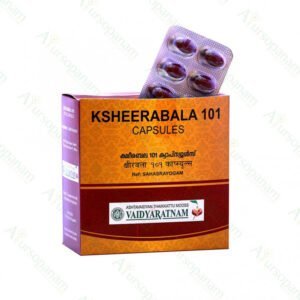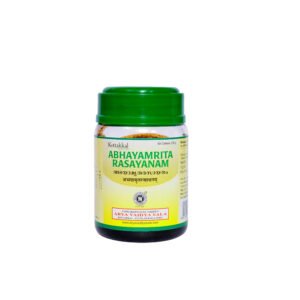Panchagavya stands for the significant five obtained from the domestic cow namely Milk, Curd, Ghee, Urine And Dung, substances hailed for their immense therapeutic value by Ayurvedic literature. Mahapanchagavya Ghritam is a medicated ghee that combines these five substances with drugs that pacify the heat of Pitta, and breaks inflammatory pathways. It is found mentioned in the context of Apasmara Chikitsa a broad spectrum of psychosomatic illnesses.
Ghees or fats are widely acclaimed for their ‘Sookshma’ swabhava, the capability to reach deep into tissues and the central nervous system. It is efficient in crossing the blood-brain barrier and delivering the therapeutic action in the desired sites of action.
Features & Benefits
- Mahapanchagavya Ghritam is an excellent nootropic action. It is found to enhance brain functions like memory, motivation, creativity, alertness, and general cognitive function.
- It enhances memory and retention.
- It stimulates intellect, cognition and speech.
- It is an effective remedy for erratic activity in the brain and central nervous system.
- It is effective in managing diseases of psychosomatic origin.
- Mahapanchagavya Ghritam is useful in supporting the treatment of anxiety, depression, convulsive disorders and mental dysfunction.
- It is used to boost intellectual activity in children with learning disabilities.
- It nourishes deeply and stabilizes mental activity.
- It enhances metabolic activity. Improves liver function and gut biome.
Dosage and Instructions
Adult: 7-10 ml of Mahapanchagavya Ghritam early in the morning on an empty stomach
Child: 5-7 ml of Mahapanchagavya Ghritam once in the morning on empty stomach.
Key Ingredients
Patala(Steriospermum souveolens)
The herb is highly effective in purifying the blood. It also treats burns, wounds, reduces blisters, and provides relief from pain and burning sensation.
Triphala
The most powerful benefits of Triphala (an Ayurvedic herbal powder) include improving digestion, reducing signs of aging, detoxifying the body, aiding weight loss, strengthening the immune system, managing diabetic symptoms, and optimizing nutrient uptake efficiency.
Hareethaki (Terminalia chebula)
Popularly known as Indian walnut for its innumerable benefits or Indian hog plum in English, it is extremely valuable for its role in improving hair health. It is useful for treating scalp infections like dandruff, itching and hair fall. It also strengthens them from the roots, prevents breakage and loss of hair and bestows silky soft, smooth hair. Chebulic Myrobalan is one of the three key ingredients in Triphala, a natural compound that provides overall support for digestive function and helps ensure that the digestive tract works at optimal levels. The Ayurvedic Pharmacopoeia of India has documented the use of the powdered herb in intermittent fevers and chronic fevers, anemia and polyuria. Chebulic Myrobalan can also be used to treat gastrointestinal and respiratory disorders.
Amalaki (Emblica officinal)
It is commonly known as the Indian gooseberry is high in Vitamin C and natural antioxidants known as flavonoids and polyphenols. When used for hair treatments, it is found to strengthen and condition follicles down to the roots. Amla oil can promote hair growth, reduce dandruff, and prevent the greying of hair.
Vibhithaki (Terminalia Bellerica)
Known as beach almonds or Bedda nut tree, it is rich in Vitamin C and other antioxidants that nourish the hair roots. Bibhitaki helps in making the roots of the hair stronger, minimizing hair fall and preventing premature greying of hair strands.
Gambhari(Gemlina arbora)
One of the Dashamoola roots, it effectively reduces inflammation and improves wound healing. The potent antioxidant properties help in cleansing the blood and removing the dullness of skin and wrinkles.
Agnimantha (Premna Integrifolia)
Agnimantha or botanically Premna Integrifolia is an important ingredient of Dashmoola Plants. Dashmoola has two subcategories Brihat Panchamoola and Laghu Panchamoola. Agnimantha is included under Brihat Panchamoola. All these plants have anti-rheumatic, anti-inflammatory and analgesic properties.
Shyonaka (Oroxylum Indicum)
Commonly known as Indian caper, it is one among the Dashamoolas. Its anti-inflammatory and analgesic in nature. It is effective in dysentery and diarrhea.
Pippali (Piper longum)
Pippali is known as “Tridoshic” herb as it suits all body types. Thus regular consumption of Pippali in suggested quantity can help you to immune your body to quiet an extent. Pippali has Anti-microbial, Anti-inflammatory activity. Consumption of Pippali is said to exhibit anti spasmodic action and hypoglycaemic effect which is believed to lower blood sugar level. It is also reported to be antagonist in respiratory depression. Also due to its cooling post-digestive effect consumption of Pippali is considered as a safe and effective option to avoid all sorts of digestive disorders.
Maricha (Piper nigrum)
It is native to the Western Ghats of India. It is cultivated for its fruit, which is widely used as a spice and in traditional Indian medicine preparation..Black pepper is an appetizer and carminative commonly used in the treatment of digestive system-related complaints like dyspepsia, indigestion, flatulence, nausea, diarrhea and colic pain. in the respiratory system, it acts like an Expectorant used in Cough, cold and chest congestion. Externally used as an analgesic and in Vitiligo it stimulates the production of pigments.
Pushkaramoola (Coffea travancorensis)
Pushkaramula has been used to treat cardiovascular and respiratory problems as well as for weight loss. Other conditions treated traditionally with pushkaramula include: bacterial infections, blood sugar metabolism problems, asthma, bronchitis, cough, and heart disease. Literature suggests it works by protecting antioxidants in the body and increasing their function
Aragwada (Cassia fistula)
Aragwada and its components have been investigated for a number of biological activities such as antiparasitic, antioxidant, antibacterial, antifungal, antitumor, antipyretic, anti-inflammatory, antiulcer, wound + healing, analgesic, hepatoprotective, immunomodulatory, and acetylcholinesterase
Kutaja (Holarrhena antidysenterica)
It is a traditional ayurvedic remedy that has potent anti-dysenteric, antidiarrheal, anti-amoebic action and hemostatic properties for treating and curing a horde of ailments including dysentery, diarrhea, irritable bowel syndrome, malabsorption syndrome, intestinal infections and different bleeding disorders.
Shunti (Zingiber officinalae)
Due to its strong flavor, Ginger is an essential ingredient in many Asian cuisines. Its therapeutic benefits have been recorded in Ayurvedic and Traditional Chinese Medicine. Ginger is a potent anti-nauseatic and is beneficial in treating upset stomach. Gingerol and shogaol, active components of Ginger, suppress gastric contractions. Both the fresh and dried rhizomes of Ginger suppress gastric secretion and reduce vomiting. The compounds 6-gingerol and 6-shogaol have a number of pharmacological properties, including antipyretic, analgesic, antitussive and hypotensive properties.
Cow’S Milk
The cow’s milk tends to balance the emotions as well as all the three doshas Vata, Pitta and Kapha. It is an important food that enhances the Ojas and vitality of the human body. Also, cow’s milk contains Cerebrosides which have a good ability to improve and regenerate brain cells.
Cow’S Ghee
It is big support as it enhances eyesight, increases the strength and also flexibility of the bones. Regular consumption of ghee boosts physical as well as mental strength. It keeps the body healthy and enhances its potency of the body.
Cow’S Curd
Curd is prepared from cow’s milk or the by-product of cow milk is dahi or Cow Curd. It has therapeutic value in many ailments like diarrhea, dysentery and is also recommended in chronic specific and non-specific colitis. The cow’s curd also prevents premature aging.
Cow’S Urine
Cow’s urine comes to use in case of ailments like intestinal worms, edema, anasarca, ascites, abdominal distension, various painful conditions and anemia.
Cow Dung
It is believed to be the holder of natural properties that are beneficial for the skin. It is naturally antiseptic, antibacterial, fungicidal and useful in serious skin conditions like psoriasis, eczema and gangrene. And thus, it is used in skin ointments for relieving and curing skin disease. Although, Cow’s dung is equally holy content as cow urine and is used to purify the environment.





















































Ratings & Customer Reviews
Reviews
There are no reviews yet.